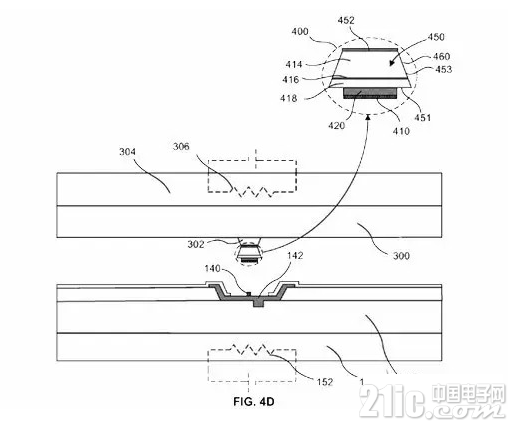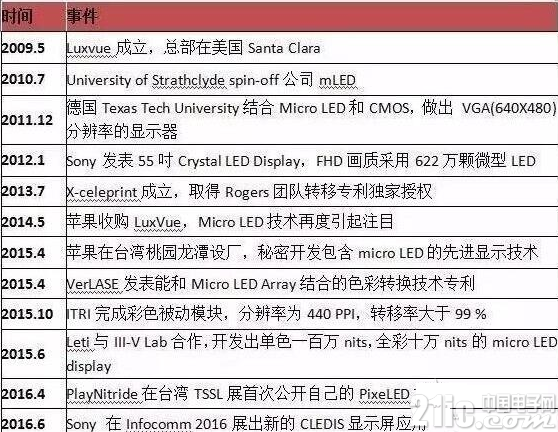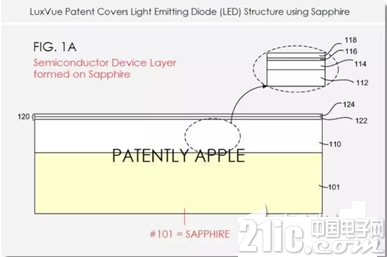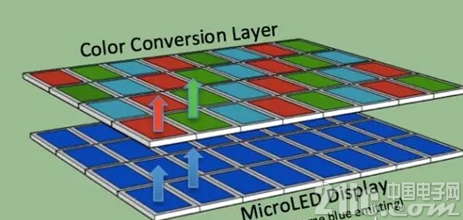Since the release of the iPhone 7, iPhone 8's various news has come, and most news about the screen reports that the new generation of iPhone will use OLED screen, which makes OLED a fire, and is considered the next generation of OLED display. Micro-LED also seems to be no longer low-key, glory at the Taiwan Solid State Lighting International Symposium. Compared to OLED, Micro-LED technology is still relatively new to many people, but the focus is getting higher and higher.
This article refers to the address: http://
The term Micro LED appeared very early. As early as 2000, Cree applied for a patent called "Micro-ledarrays with enhanced light extracTIon". Later, related papers were published, but Micro LED is only pure academic research. LED factories and panel factories have also been secretly researched and developed for many years, but they have not really become commercialized.
What is Micro-LED?
MicroLED technology, namely LED miniaturization and matrixing technology. Refers to a high-density and small-sized LED array integrated on one chip. For example, each pixel of the LED display can be addressed and driven separately. It can be regarded as a miniature version of the outdoor LED display, and the pixel distance is from millimeter. The grade is reduced to the micron level.
The Micro LED display, on the other hand, uses the normal CMOS integrated circuit manufacturing process to make the LED display driver circuit, and then uses the MOCVD machine to fabricate the LED array on the integrated circuit, thereby realizing the micro display, that is, the LED display. A reduced version of the screen.

Patent for LuxVue Active Matrix Micro LED display application
Image source: LuxVue
The development of Micro-LED

Prominent advantage
The advantages of Micro LED are obvious. It inherits the characteristics of high efficiency, high brightness, high reliability and fast response time of inorganic LED, and has the characteristics of self-illumination without backlight. It is more energy-saving, simple in mechanism and small in size. Thin and other advantages.
In addition, a major feature of the Micro LED is its high resolution. Because of the ultra-small performance, the resolution of the performance is particularly high; it is said that if the Apple iPhone 6S uses micro LED, the resolution can easily reach 1500ppi or more, which is 3.75 times higher than the original ReTIna display of 400PPi.
Compared with OLED, the color is easier to accurately debug, has a longer luminous life and higher brightness, and has better material stability, long life, and no image imprinting. Therefore, another display technology with lightness and power saving advantages after OLED is common to OLEDs in that it needs to be driven by a TFT backplane, so the TFT technology grades are IGZO, LTPS, and Oxide.
Disadvantages
1. Cost and disadvantages of large-area applications. Relying on a single crystal silicon substrate as the driving circuit, and from the previous patent published by Apple, there is a step of transferring the LED from the sapphire substrate to the silicon substrate, which means that at least two sets of substrates are required to make a screen. Independent process. This leads to an increase in costs, especially in large-area applications, where there are significant challenges to yield and cost. (For a single crystal silicon substrate, one or two inches is already a large area, with reference to the price of full-frame and larger medium-format CMOS sensor products.) Of course, LuxVue converts the drive circuit substrate to quartz or It is feasible to reduce the cost of large-area applications, but it also takes time. Compared to AMOLED's mature LTPS+OLED solution, there is no cost advantage.

2, the luminous efficiency advantage is threatened or even overtaken by PHOLED. The efficiency of Phosphorescent OLED (PHO LED) is obvious. UDC's red and green PHOLED materials have also been commercialized on the Samsung Galaxy S4 and subsequent models. The panel power consumption has been level with the high PPI TFT-LCD. Or a slight advantage. Once the lifetime of blue-light PHOLED materials is solved and commercialized, inorganic LEDs will not be as efficient in terms of efficiency.
3. Brightness and longevity are threatened by QLED. QLED research is very hot now. From the data provided by QD Vision, both efficiency and longevity are very promising, and there are many large companies engaged in this research. Of course, QLED is also a strong competitor of OLED.
4. It is difficult to make a curl and flexible display. The flexible display of OLED and QLED has a good prospect, and there have been many Prototype displays, but it is more difficult for LuxVue to make curl and flexibility. If you want to make a product like iWatch, the screen does not have a certain curvature is less aesthetic.
status quo
Speaking of the development status of microLED, as the current CEO of Nouvoyance is also the founder of P-array in Samsung OLED panel, Candice Brown-Elliott said that before Apple acquired LuxVue, few people knew and engaged in the field, and now many people have started. Discuss this technology.
Two Micro-LED technology experts also said last year that the technology level is still difficult to apply and produce a variety of practical screen panels, and it is unlikely to see this screen technology in iPhone, iPad or iMac products in the near future. But for smaller displays, Micro-LEDs are still a viable option, such as AppleWatch and other small screen applications.

Ver LASE's Micro LED array for near-eye display (NED) applications
Image source: Ver LASE
In fact, since LuxVue was acquired by Apple, VerLASE has announced that it has obtained a breakthrough patent for color conversion technology. This technology enables full-color Micro LED arrays to be used in near-eye displays, and has not been reported since. Recently, Xiao Bian got news from the recent solid-state lighting seminar in Taiwan. LeTI, Texas Tech University and Play Nitride all showed their micro LED development results at the seminar.
LeTI introduced the iLED matrix, which has a Blu-ray EQE of 9.5%, a brightness of 107Cd/m2, a green EQE of 5.9%, and a brightness of up to 108Cd/m2. It uses quantum dots to achieve full-color display, and Pitch has only 10um. 1um. Leti's short-range plan cuts in from smart lighting, enters HUD and HMD market in 2-3 years, and grabs VR/AR heat. The remote target is to cut into large-size display applications within 10 years.
The Pixe LED TMdisplay technology, also based on GaN, announced by Taiwan's Play Nitride, is currently transferred to the panel through transfer technology, with a transfer yield of 99%!
It can be seen that many companies in Micro LED technology are following up and the speed of development is also accelerating. However, as far as Apple itself is concerned, this technology belongs to Apple's laboratory technology, and Apple itself has bet on many emerging industries, so it is still to be observed whether mass production will be introduced in the future.
Bottleneck of development
In fact, the core technology of Micro LED is the transfer of nano-scale LEDs, rather than the technology of making LEDs. Due to lattice matching, LED micro devices must first be grown by molecular beam epitaxy on sapphire substrates. To make a display, it is necessary to transfer the LED light-emitting device to the glass substrate. Since the size of the sapphire substrate on which the LED micro device is fabricated is basically the size of the silicon wafer, and the display is a glass substrate having a much larger size, it is necessary to carry out multiple transports.
The technical difficulty of multiple transfer of micro devices is particularly high, and it is more difficult to use in products that pursue high-precision displays. It is also seen from the list of patents published after Apple’s acquisition of Luxvue that most of them use the electrical method to complete the transshipment process, so this is the key core technology of Luxvue.
Li Yunli, CEO of Taiwan's Minchuang, also said recently: "The key to success of Micro LED is two: one is the willingness of Apple and Samsung brands; the other is wafer handling technology, which carries millions of ultra-small LED chips at a time. get over."
In fact, Micro LED also faces the third problem, namely, full color, yield, and wavelength consistency. The monochromatic Micro LED array can be realized by flip-chip package and driver IC bonding, but the RGB array needs to be divided into red, blue and green crystals, and hundreds of thousands of LED dies need to be embedded. Granular light efficiency, wavelength consistency, and higher yield requirements, while the cost of binning is also a technical bottleneck that hinders mass production.
They look like this
Micro LEDs have low technical barriers for wearable devices and may be rapidly launched as experimental products. However, their market size is relatively small compared to TVs and mobile phones, so it is the final market for Japan and will focus on development. The application is sequentially displayed on the screen, notebook, mobile phone, etc.
——The technical director of the second department of Nichia
Due to the small size of the Micro LED, the epitaxial and grain processing of the crystal is co-developed with the transfer equipment and system applications. In the process of epitaxial and grain, the probability of success of Micro LED is high. As for whether it can be mass-produced and shipped next year, it will be very hard. Micro LED needs to have good technology and patent ability, and it must be jointly developed by materials, equipment and system factories, and the threshold is high, especially red LED. Crystal has an advantage in killer applications.
- Crystal Power spokesman Zhang Shixian
Micro LED is a new technology, a new application, and has the opportunity to increase the amount of LED usage, which is one of the directions for the new application of Ronda's layout. At present, many companies are in the process of layout, and the progress is different. As for when it is possible to commercialize mass production, he believes that the learning curve of poor initial yield and more people's investment after improvement can not be omitted. Technology is always innovating from generation to generation, and Ronda is ready.
——Su Fengzheng, Chairman of Ronda
Editor's conclusion
After the actual measurement, ITRI determined that Micro LED is more suitable for wearable equipment than OLED. After the former technology matures, the price is relatively more competitive. Micro LED technology can not only be applied to display, but also integrates various sensors as the development direction, and will play a key role in applications such as wearable devices and smart phones. However, due to the fact that the Micro LED is different from the existing LED industry chain in terms of IC, detection, transfer technology and application, the LED factory has invested in the research and development of Micro LED, but it has not gained the upper hand. However, once the development of Micro LED is successful, Taiwan's semiconductor and LED industries are expected to benefit, especially to solve the overcapacity problem.
Yuhai company develop and produce of various rings sizes, bearing variety of electrode and metallisation configurations. This variety of Rings is fabricated from various material formulations for applications such as high power, sensitivity, stability.
Features
· • electrode type on request
· • Surface roughness on request, for specific demanding application
· • Thickness/Radial frequency tuning available on request
• Wide choice of PZT formulations
Applications include
• Sensors
• Welding
• Ultrasonic cleaning
• Precise Measurement
• Ultrasonic scalpel
• Cauterisation
• Phacoemulsification
• Therapeutic ultrasound
• Accelerometers
Dimension range
|
Outer diameter |
3-180mm |
|
Inner diameter |
1-150mm |
|
Thickness |
0.2-25mm |
Piezo Ring,Pzt Ring,Piezoelectric Ceramic Ring,Piezo Ceramic Ring
Zibo Yuhai Electronic Ceramic Co., Ltd. , https://www.yhpiezo.com
